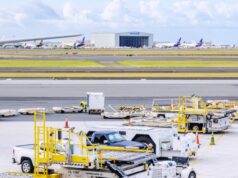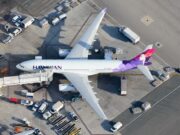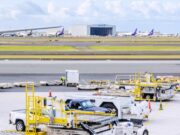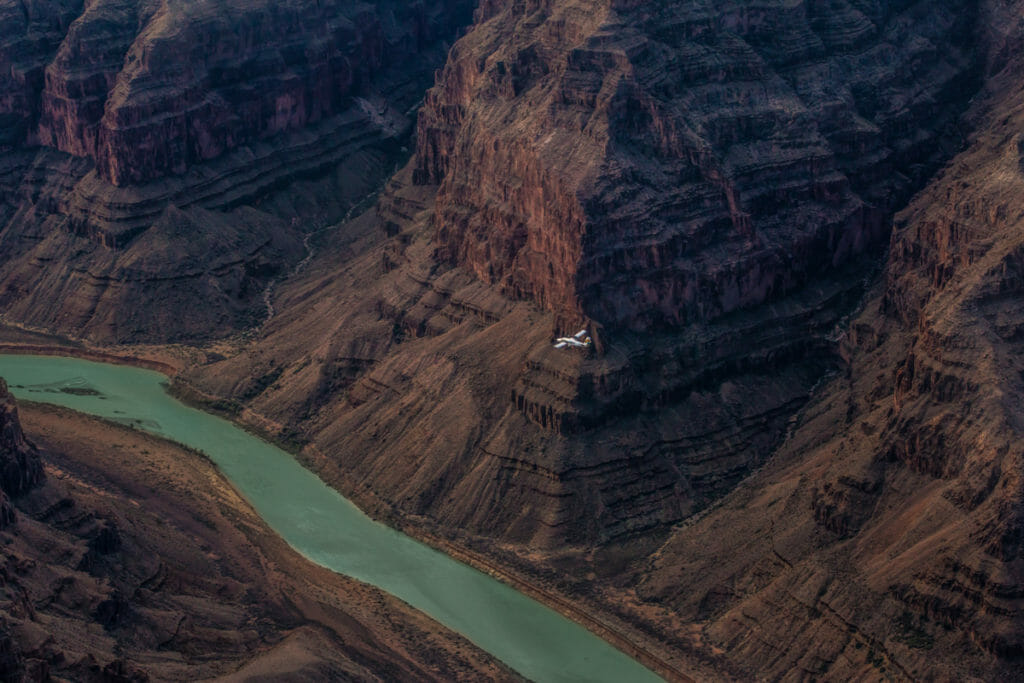
The aerial view of the Grand Canyon is an endless swath of colors and lights, deeply grooved stretches of rock, tiny trees speckled about like a handful of carelessly-flung pepper, and ant-sized tourists milling around a giant mile-deep gash in the earth. For ninety years, Grand Canyon Scenic Airlines has been giving passengers the opportunity to have a spectacular experience of seeing this view from both the air and the floor of the canyon. In 1927, the airline became one of the first to operate flight tours around the Grand Canyon; in the 1960’s, they began to use helicopters to travel all the way to the bottom. Today, they continue to create memories for those who pay a visit to one of the World’s Wonders.
In the 1920’s, air travel was still a relatively new phenomenon, and its potential largely untapped. The freedom of flying opened up vast opportunities for financial gain as well as providing people access to otherwise unreachable places. It was in 1927 that Parker Van Zandt, the soon-to-be founder of what would eventually become Grand Canyon Scenic Airways, was working for Ford Motor Company as a pilot. Flying across the canyon to deliver goods to Ford, Van Zandt realized the beauty and awe of seeing the view from above. Deciding he must share this with others, he left his position at Ford and began the plans to create what would form the base of Scenic Airlines.
After establishing his business plan, Van Zandt joined with investors to launch Scenic Airways, with its first tour flight taking place on October 3, 1927. Six passengers, flying in a Stinson Detroiter SM-1 aircraft, were able to glimpse the view that Van Zandt was so eager to share. He flew his tour from one rim of the Grand Canyon to the other, and as word about the aerial tours spread, the airline continued to grow. Within a year of launching Scenic Airways, Van Zandt also purchased 278 acres of farmland that skirted the city of Phoenix. With a mere $125,000, he created Sky Harbor – which would eventually become Sky Harbor International Airport – building a hangar, landing strip, and office spaces for the employees of the small airline. Soon after, Scenic Airways completed its first commercial flight into Mexico.
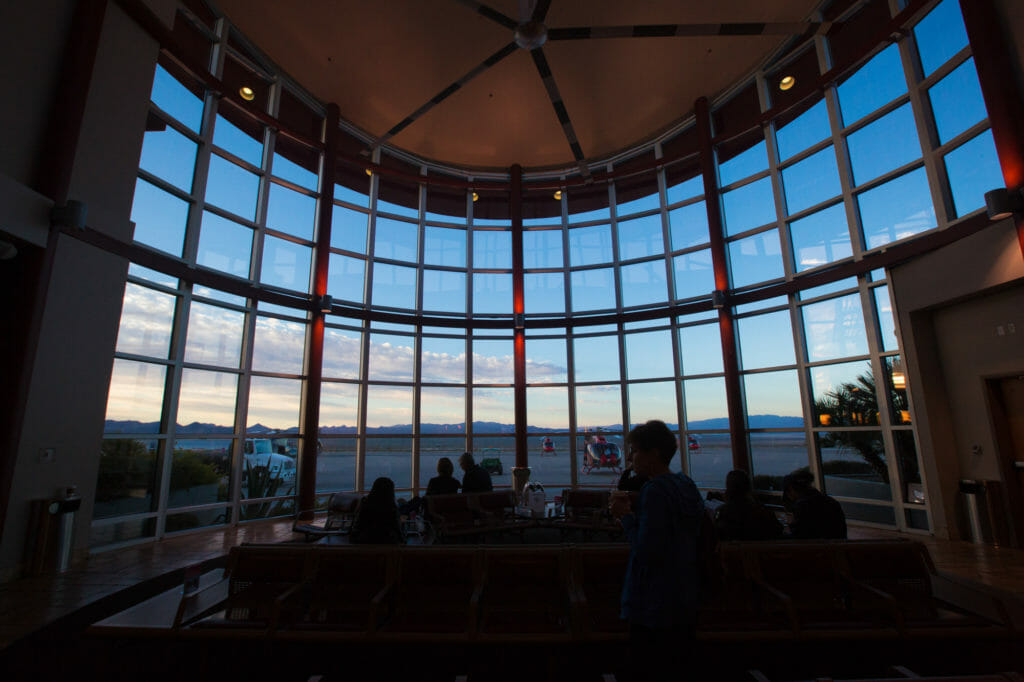
Although Scenic Airways took off with a flying start, the Great Depression loomed in the future. By 1930, Scenic Airways was sold to local Arizona businessmen, Jack Thornburg and Irving Kravitz. Though the airline was liquidated, it was reopened under a new name, Grand Canyon Airlines, and was operated by pilots in the area. By 1931, the new airline was flying commercial tours. In the coming years, Grand Canyon Airlines changed owners a few times before falling into the hands of someone who would create yet another aspect to the airline’s success and longevity.
In 1963, Elling Halvorson owned a construction company that specialized in high-risk environments. At the time, the National Park Service was accepting bids to build a pipeline across the entire canyon, one that would provide water from the North Rim to the South Rim. Because of his special expertise, Halvorson won the bid and set upon the construction of the massive project.
The pipeline was 13.5 miles long, and would require helicopters to complete the job. Halvorson, a helicopter pilot himself, used these aircraft to transport supplies to base camps at the build sites, providing lumber and other materials to the builders. The helicopters could easily fit inside the canyon, simplifying the otherwise nearly impossible task. The pipeline construction was moving along smoothly, but before long, a new opportunity presented itself to Halvorson.
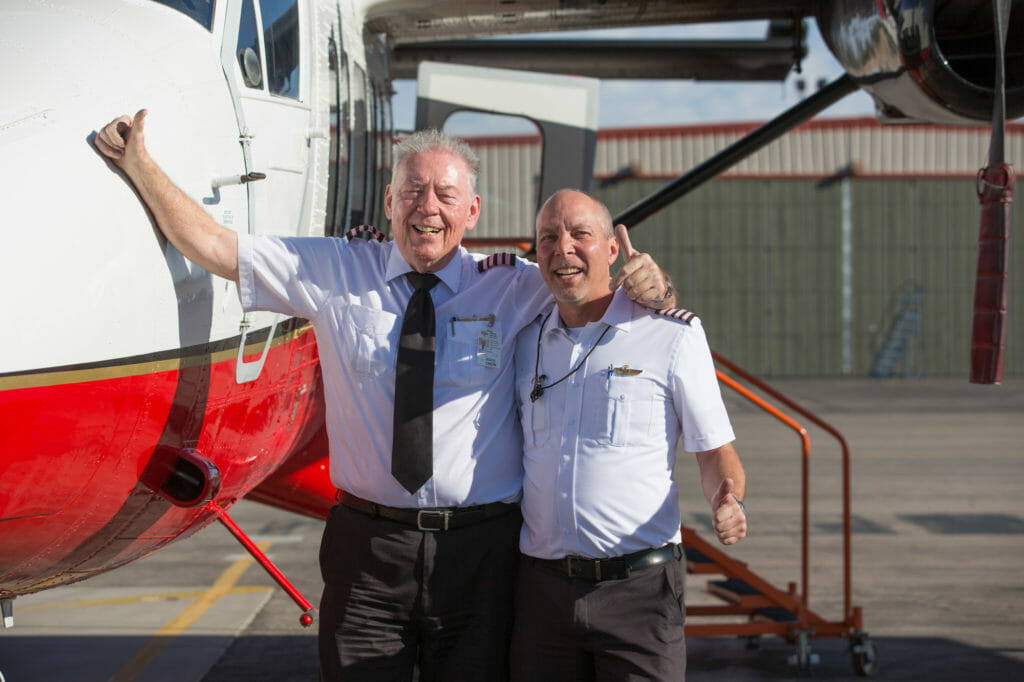
As the workers began to see the aerial views from the helicopters as they ferried supplies, interest started to spread. Suddenly, workers were asking to bring along their families for a ride in the helicopters so they, too, could get a glimpse of the magical canyon, both from up high and from its floor. Locals too, who would gather to watch the pipeline construction, began to inquire about taking a tour in a helicopter. After all, Halvorson’s helicopters were the first aircraft able to land inside the canyon. In 1965, Halvorson, noting this potential for a lucrative business, established Grand Canyon Helicopters and began to operate aerial tours using Bell 206 Jet Ranger aircraft.
Realizing that the airline also needed airplanes, in 1967, Halvorson purchased Grand Canyon Airlines – the original Scenic Airways – from its owners, the Hudgins family. Shortly after, Grand Canyon Helicopters purchased Papillon Helicopters, a Hawaiian helicopter company. This was to further the business and also provide access to an international line of flight operations. Papillon and Grand Canyon Airlines still operate today, growing from a mere two helicopters and 1000 passengers to 80 aircraft and has flown over seven million passengers on tours in the last 50 years.
During the time that Halvorson was creating and building his touring airline, John and Elizabeth Seibold were operating their own airline, Scenic Airlines (different than Van Zandt’s Scenic Airways), flying fixed-wing Cessna airplanes on tours of the Grand Canyon and the surrounding areas. In 1993, it was one the of the world’s biggest fixed-wing aerial tour operations. In 2007, the Seibolds sold Scenic Airlines to Grand Canyon Airlines, and in 2009, both airlines began to operate under one certificate, marking Grand Canyon Airline’s 90th anniversary in 2017.
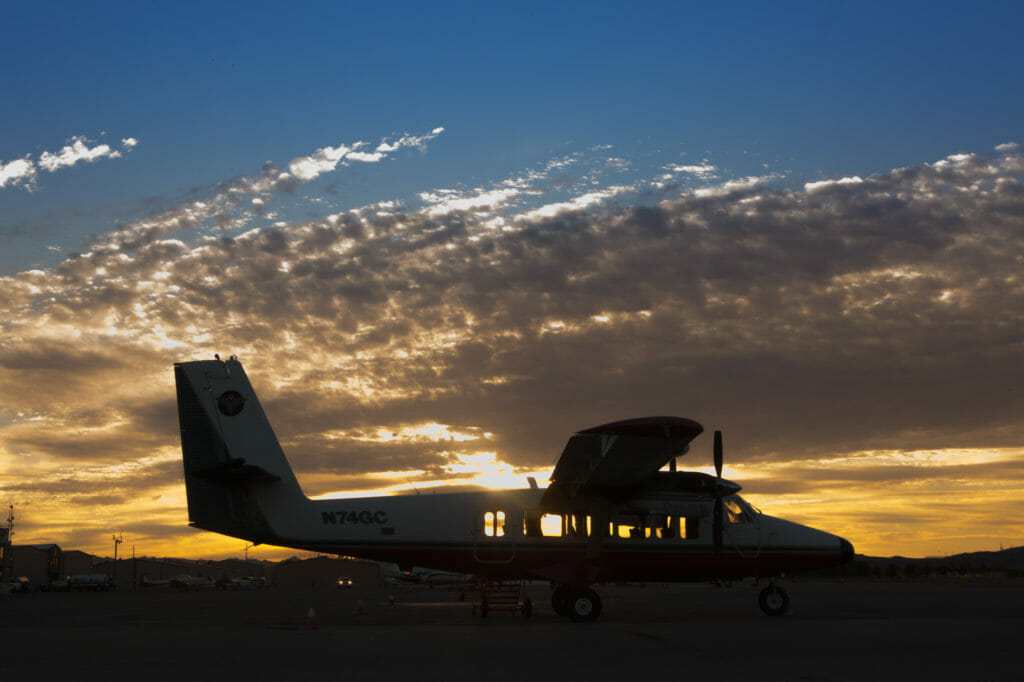
The airline still offers vast opportunities to see spectacular views from both helicopters and airplanes. Grand Canyon Airlines employs pilots who are able to have an equal work-life balance, as the tours are given daily and can be completed in just a few hours. As a pilot for GCA, tours are a chance to bring new visitors on an adventure, while also being able to enjoy beautiful views themselves. The pilots for GCA enjoy interacting with the tour-goers, eager to provide them with views of the Grand Canyon National Park as well as more specific tours of Antelope Canyon, the West Rim, and the more untouched region of the canyon, the North Rim. Tours can be taken at any time of day, during sunrise, sunset, and during different weather patterns, including awe-inspiring views of snow-covered mountains.

Today, the airline – and its partners – is still run and managed by the Halvorson family, with Elling Halvorson’s daughter, Brenda, its current CEO. Jake Tomlin, president of the Grand Canyon Scenic Airlines, manages the branch of the airline dedicated to fixed-wing operations. A Naval Academy graduate, Tomlin now enjoys sharing his love of flying working for the airline, developing new products, and piloting his own tours through the Grand Canyon. Since it began as a family business, keeping that bond alive throughout the years of the airline’s history, has been pivotal in strengthening the success of what started as a small aerial tour operation.
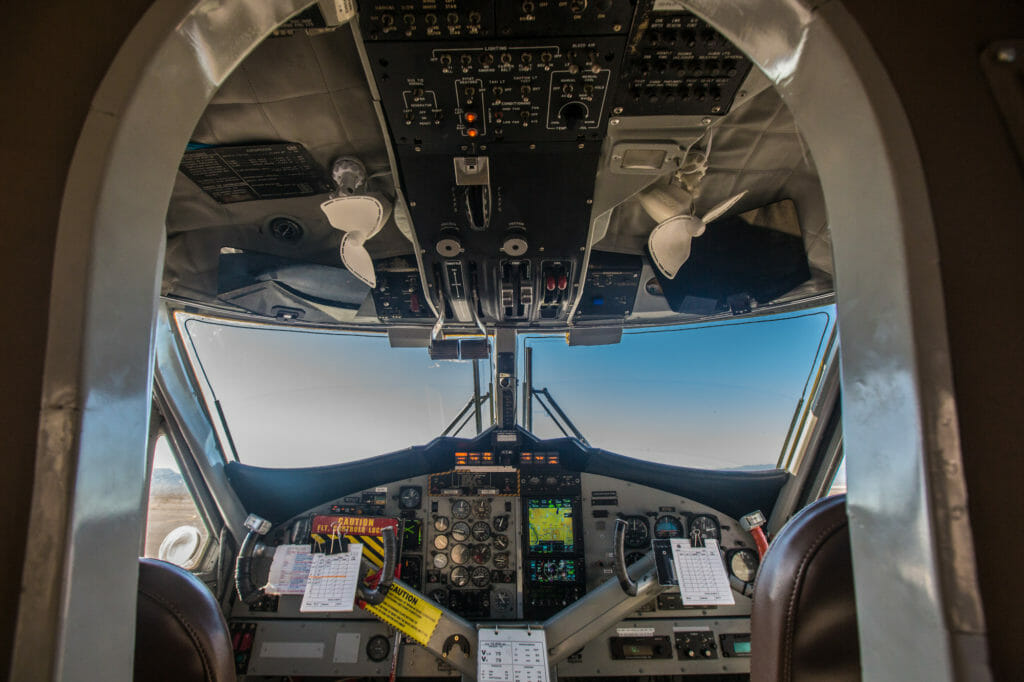
Grand Canyon Airlines has heart and soul, and continues to share that with the general public almost 100 years after it was founded. Whether offering jobs to pilots who are looking for a unique career, giving passengers a view and experience of a lifetime, or employing ground crew who manage the wide array of operations to keep the airline running smoothly, Grand Canyon Airlines seeks to provide opportunities for those willing to take a chance on something new and exciting. From Parker Van Zandt’s small six-passenger airplane to multiple aircraft and millions of passengers, Grand Canyon Airlines plans to thrive for years to come.
Interview with Dave McIntosh, Chief Pilot
Pre Interview:
Craig: How do you select applicants to be brought in for an interview?
Dave: Applicants visit the company website, www.flygcsa.com to fill out an application. GCSA will also place an ad on www.climbto350.com website and word of mouth and referrals/recommendations by current employees.
C: What can an applicant do to increase their chances of being called for an interview?
D: We find that applicants that have obtained their CFI, CFII and or MEI ratings do well in the interview process. This also helps cut down on training cost and reduces the time from being a new hire to being a line pilot.
C: What is the best way to prepare for an interview with your company?
D: Study the AIM, become familiar with the part 135 regulations. Be able to interpret weather information from TAF and Metar reports. Just be yourself.
Interview:
C: Do you recommend that applicants get to your headquarters city the day before and get a hotel room for the night?
D: It’s always best to arrive the night before and don’t stay up late studying.
C: Can you walk me through a typical day of interviews?
D: 9:00 AM: Interview. Fill out application. Interview will be with the Chief pilot and Director of Training and/or the Director of Safety. First 10 minutes of getting to know you and personality. Brief history of the company and company values, benefits and expectations. Applicant is asked if he or she has any questions for us. Always have some questions for the interviewee is best, shows us that the applicant has been doing their homework and are interested in what we do. Next followed by a flight from A to B with a brief of an approach plate and weather related to that approach.
C: What kind of questions can an applicant expect to be asked?
D: With current weather are you legal to shoot the approach? Explain the circle to land procedures. How would you execute the missed on a circle to land?
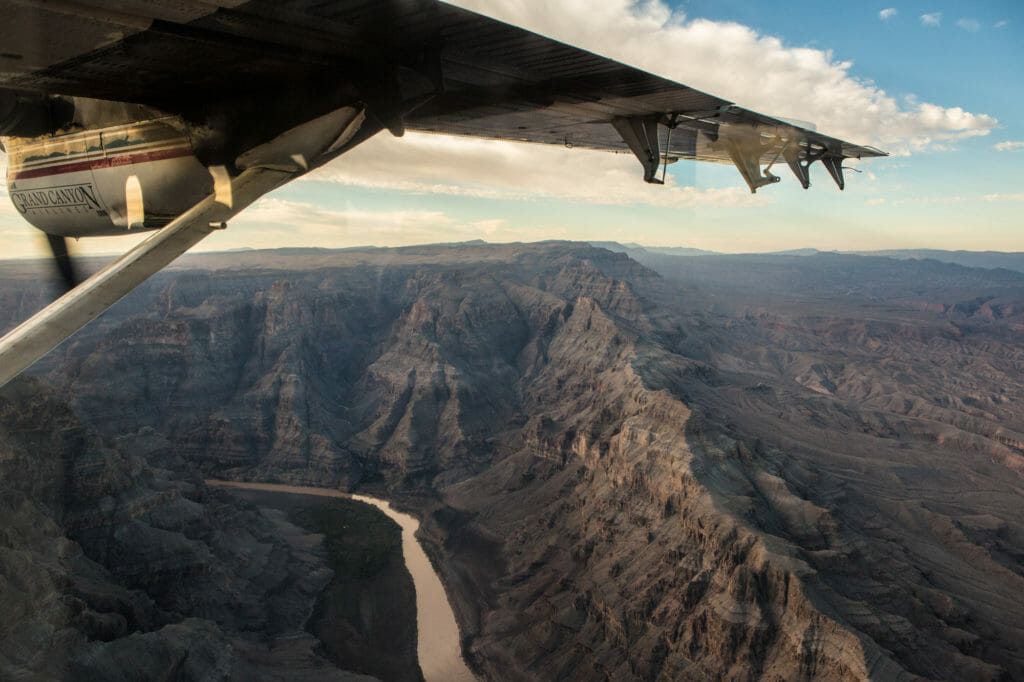
Written test:
C: Is there a written or computer test?
D: No not at this time but that has been used in the past.
Simulator Evaluation:
C: Do you have a simulator ride?
D:
Yes
C: What type of aircraft is used for the simulator evaluation?
D:
We use a Piper Navajo, ATC-820.
C: What types of scenarios should an applicant expect in the simulator evaluation?
D: Basic IFR departure, climbing turns to headings and altitude followed by interception of a radial inbound or outbound. Tell me where you are in the airspace. Enter a hold. Execute a full ILS approach and/or a VOR approach followed by possible miss and/or full stop.
C: What are you looking for in the simulator evaluation?
D: Good situational awareness basic IFR skills.
Post Interview:
C: Do you tell applicants they are hired in person that day?
D: Yes, if the interview went well, or no more than a week.
C: How soon can an applicant expect a class date after being hired?
D: Less than a month.
General:
C: How many pilots does your airline expect to hire this year?
D: 20 or more
C: Do you have a hiring bonus? Is there any specific criterion to qualify for the bonus?
D: Not at this time.
C: Can you describe the flow through program that GCSA has with Allegiant Airlines?
D: We have a mentoring and flow through program with Allegiant Airlines. To qualify for the flow through pilots need 2,500 hours of flight time at GCSA, 1,000 of this time must be PIC. This will take approximately 3 years at GCSA. Our first candidates started at Allegiant Airlines about 4 weeks ago.
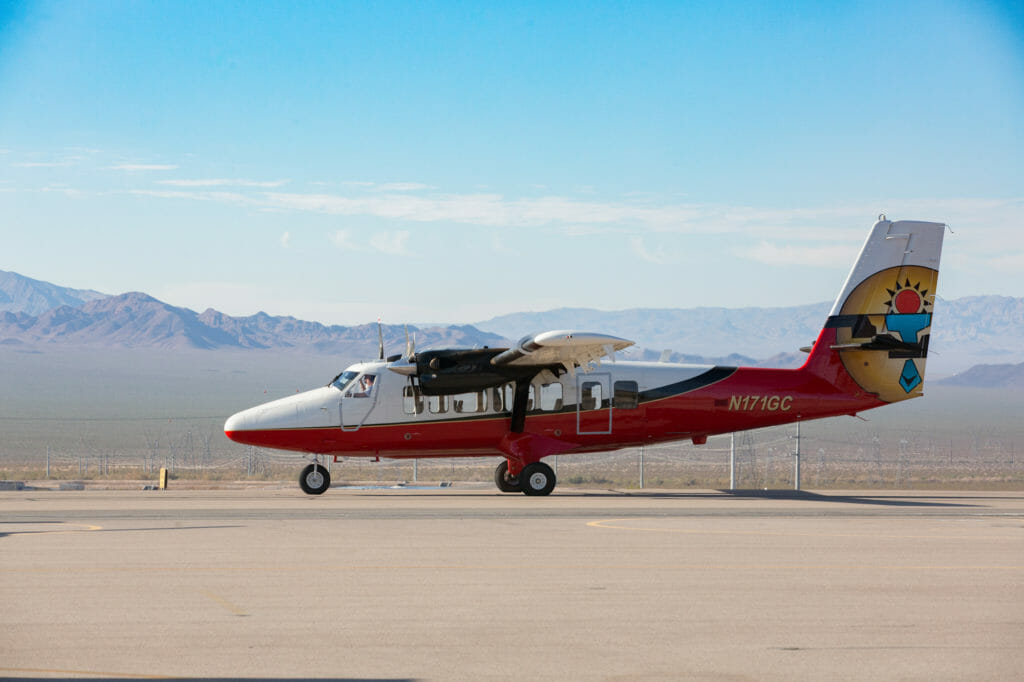
Grand Canyon Scenic Airlines Fast Facts:
Headquarters: Boulder City, Nevada
Year Founded: 1927
Number of employees: 200
Number of Pilots: 56
Number of Aircraft: 24 (16 x DHC-6-300 Vistaliner Twin Otters & 8 x Cessna 208 Caravans)
Most Junior Captain: September 2017
Number of Passengers (Yearly) 200,000
Number of Bases: 4, Boulder City, Grand Canyon West,
Grand Canyon National Park/South Rim and Page, Arizona
Number of Cities Served: 8, Boulder City, Grand Canyon West, Grand Canyon North, Grand Canyon National
Park/South Rim, Page, Arizona, Marble Canyon, Kanab & Monument Valley
Key Benefits: Home every night, Introduction to flying in a two crew environment, Working for a stable company, Family atmosphere, Dedicated upper management, Agreement with Allegiant Airlines, Company is known worldwide, Safety Record
Web: www.FlyGCSA.com
Phone: 702-638-3200
Credits:
Jake Tomlin, President, GCSA
Dave McIntosh, Chief Pilot
Christopher ‘Kippy’ Aldridge, Director of Training
Marina Nicola, Vox Solid Communications
Meredith Edwards, Author

































































